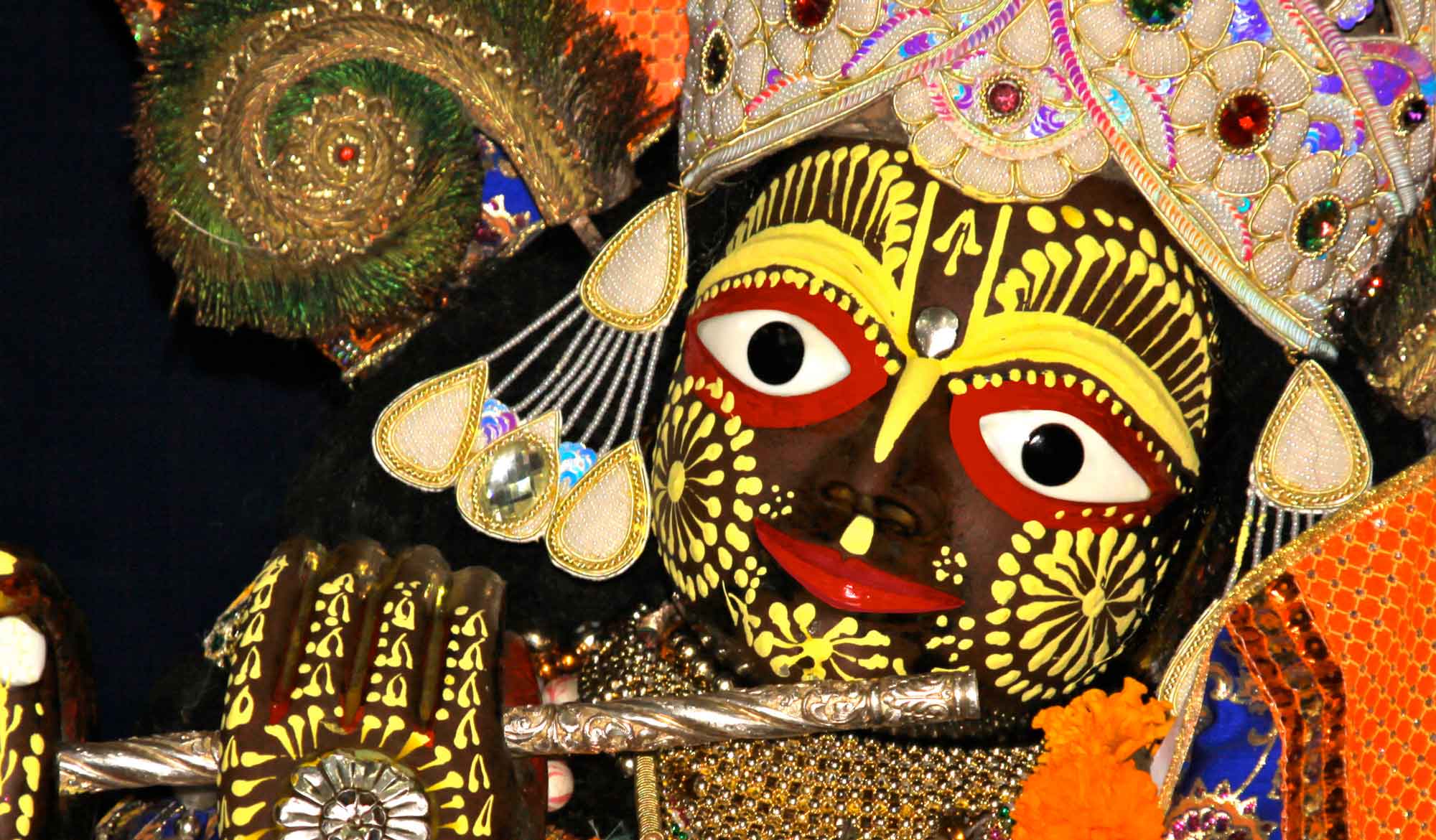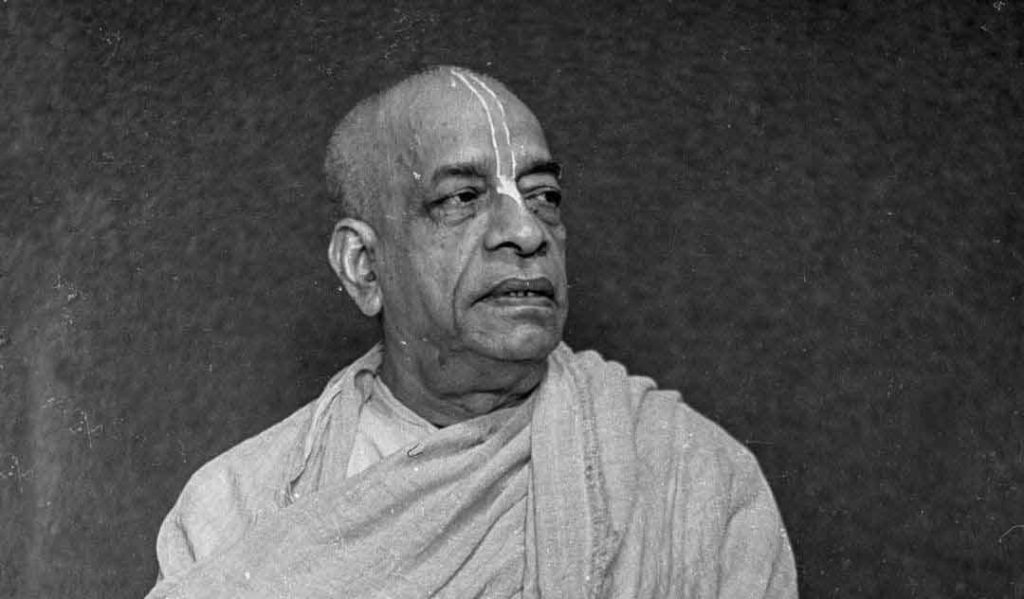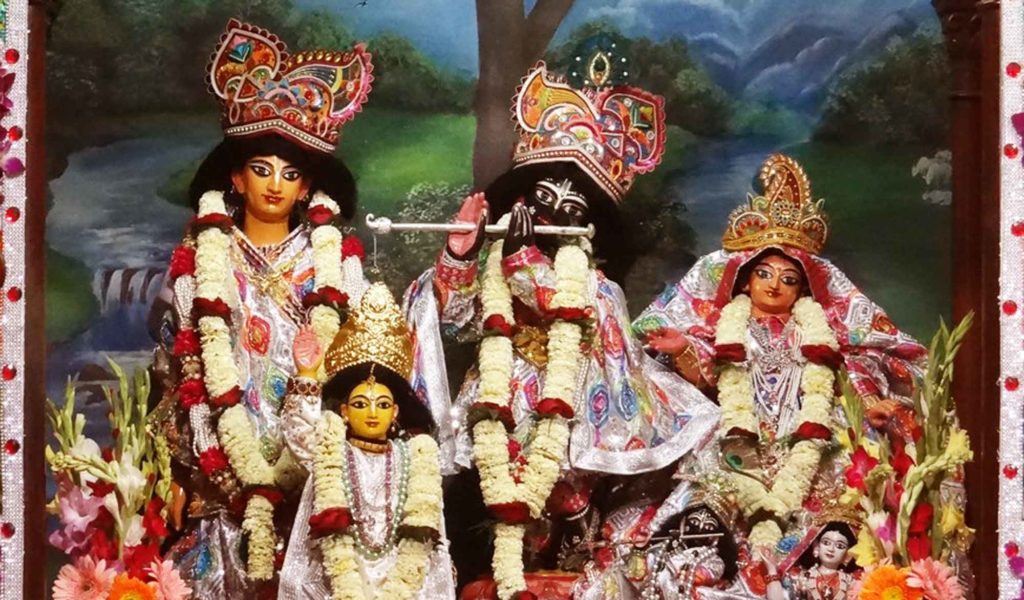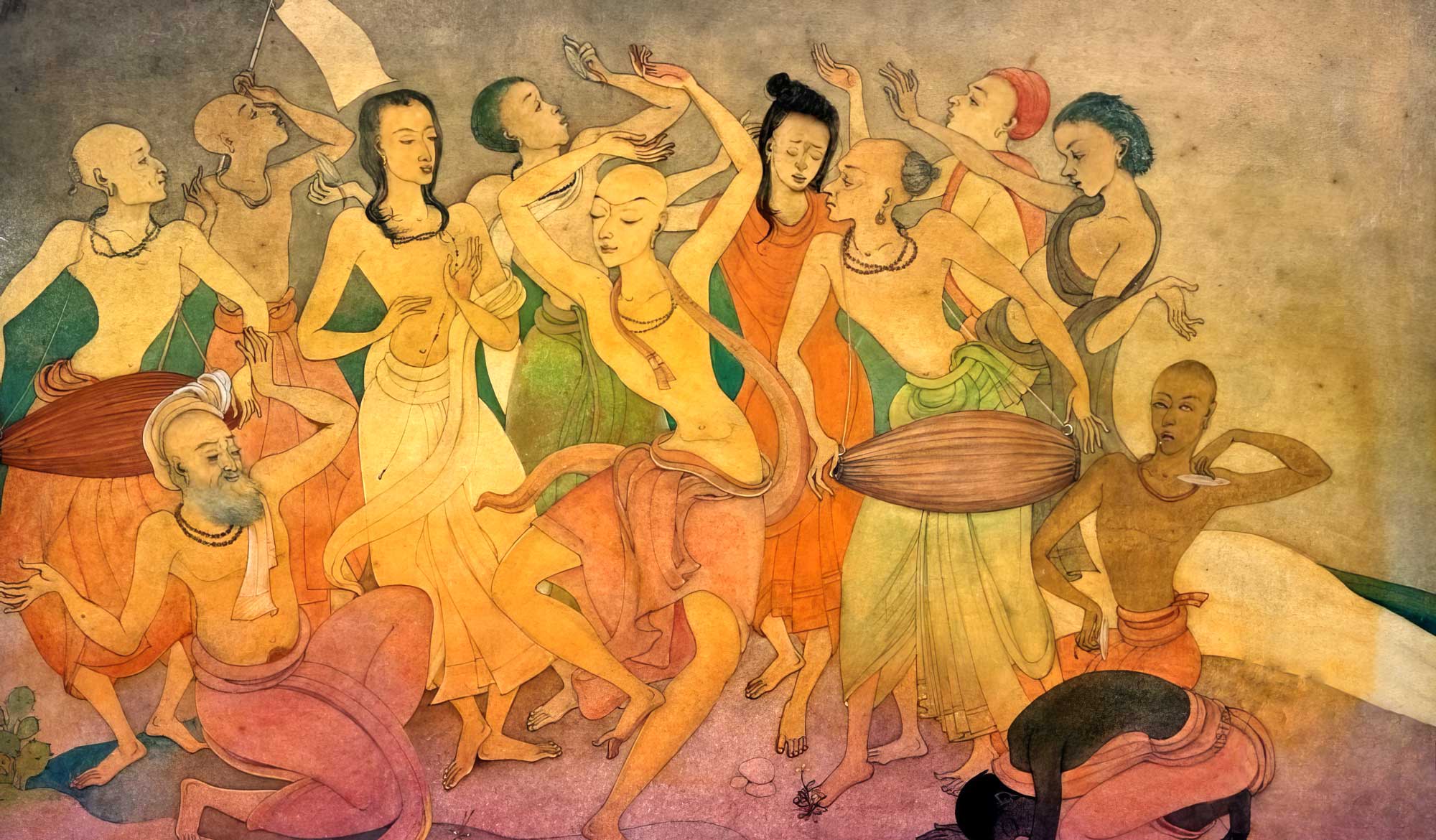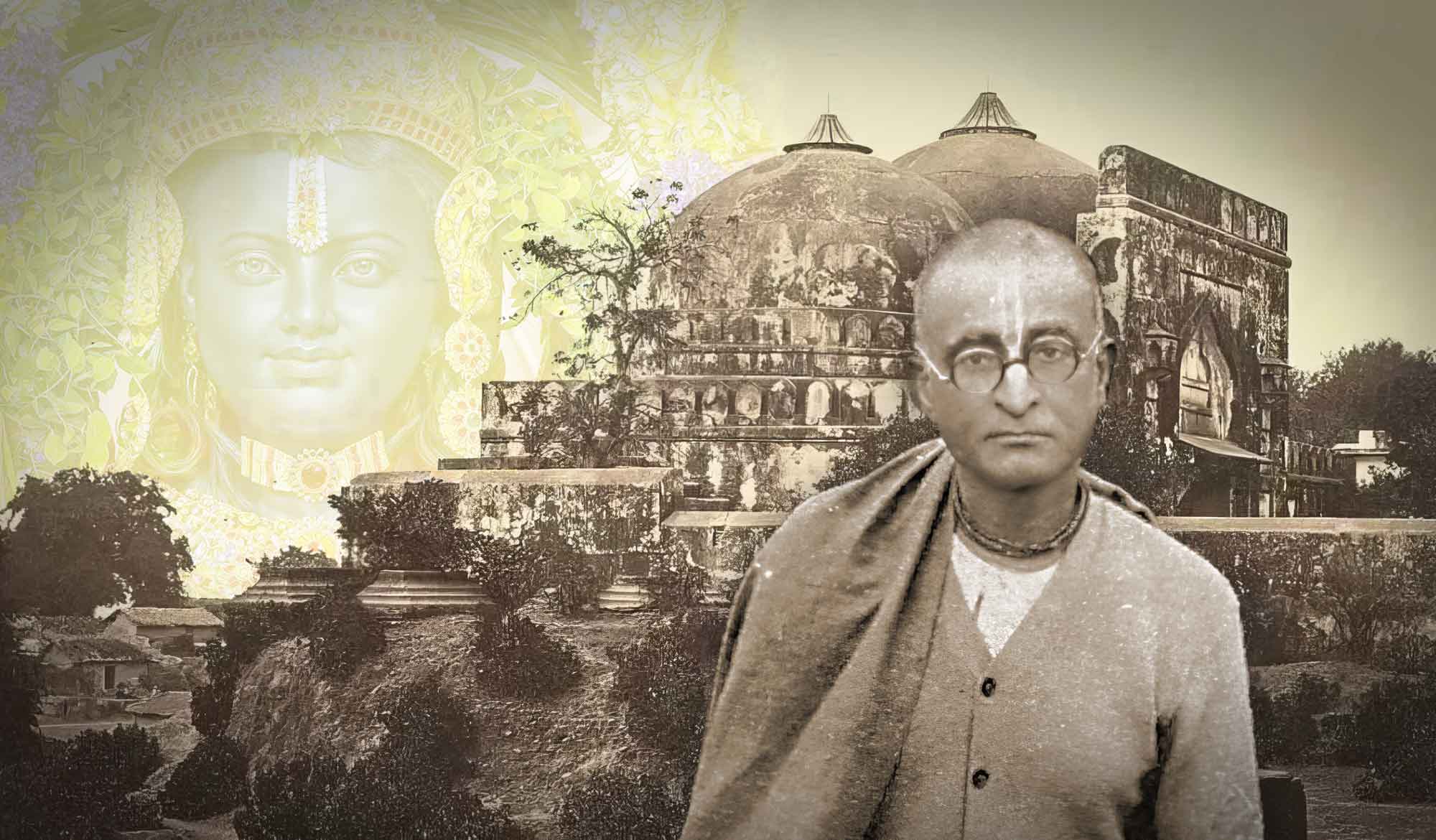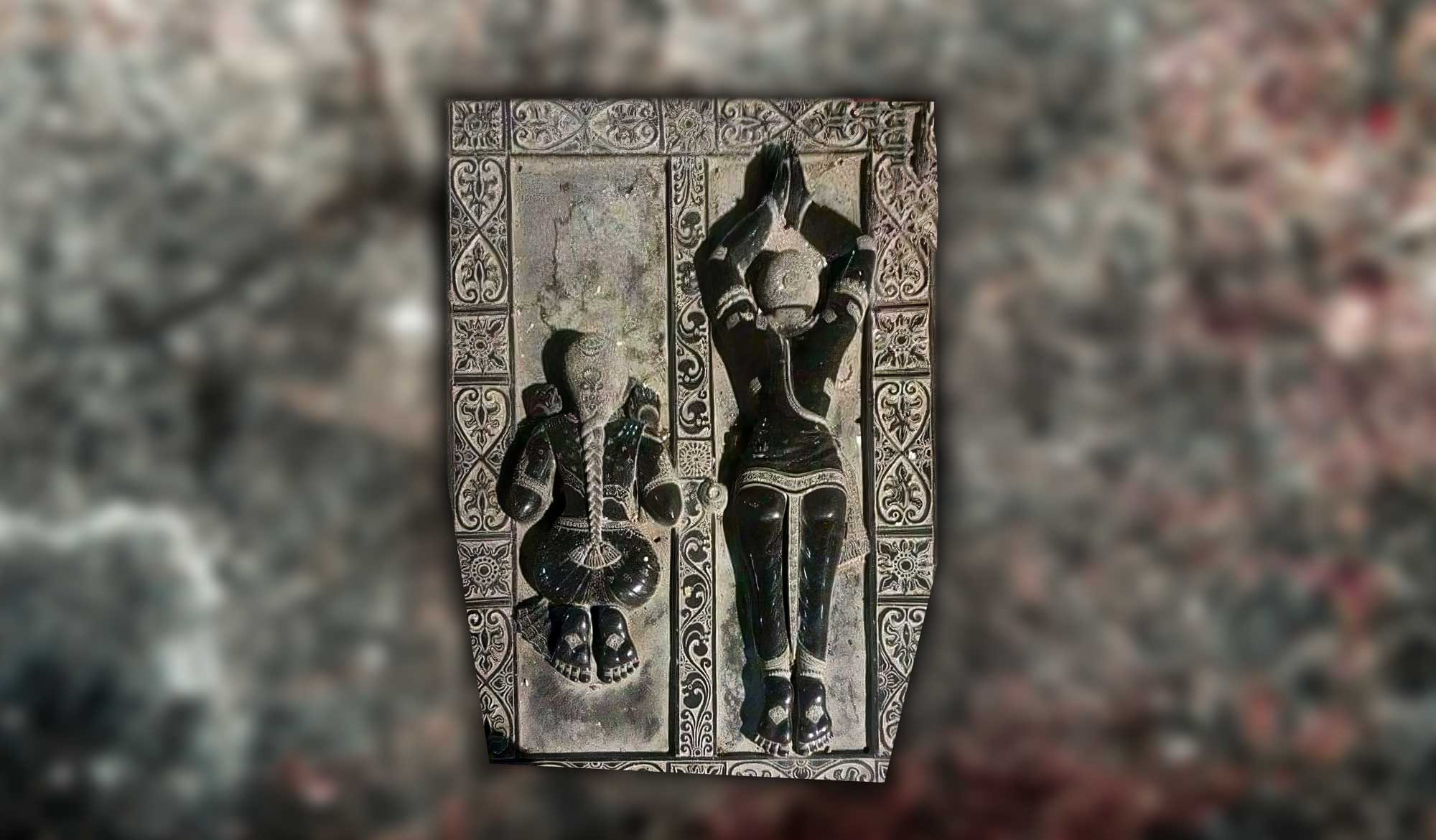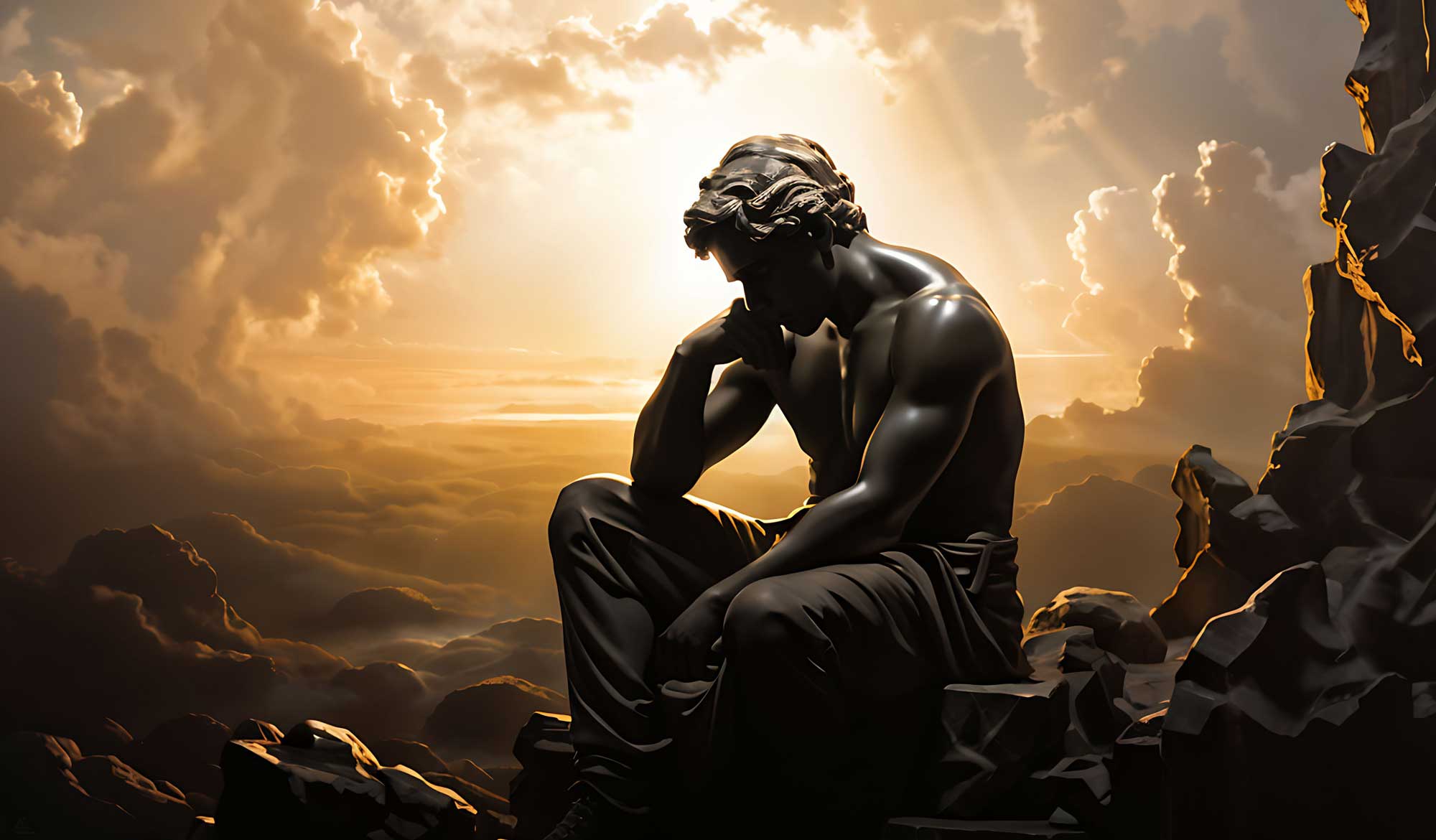Overview
“The Mystery of the History of the Līlā of Dāmodara'” was written by Swami B.G. Narasingha in January 2017. Narasingha Maharaja explains something about the history of the Deity of Śrī Dāmodara at Rādhā-Dāmodara Temple in Vṛndāvana, and asks, “Are all the old Deities of Vraja made from the same type of stone?”
Devotees throng by the tens and hundreds of thousands every year, and especially during the month of Kārttika, to have darśana of Śrī Śrī Rādhā-Dāmodara and to circumambulate the temple. The Deity of Dāmodara with Śrī Rādhā to His left and Śrī Lalitā to His right is the eternal blackish form of Śrī Kṛṣṇa appearing in Vraja to satisfy the desires of His pure devotees. But much to the amazement of the observant devotee, Śrī Dāmodara has changed His blackish colour to that of an effulgent brown! Not only has Dāmodara changed His colour, but all the original Deities of Śrī Kṛṣṇa in Vraja, and those that have gone elsewhere such as Govindadeva and Gopinātha in Jaipur, are changing their colour to brown as well! This is indeed a mystery.
We first began noticing this transformation of Dāmodara about 15 years ago when we observed small brown spots appearing on Dāmodara’s chest, arms, legs and face. This brown blemishing continued until such time that the Deity manifest as an effulgent brown colour from head to toe. Then, about a year ago, we began to notice a similar transition of colour in all the ancient Deities of Vraja and also in more contemporary Deities such as Vṛndāvana-candra, established by Kṛṣṇa Dāsa Kavirāja Gosvāmī. Were we witnessing some sort of miracle or possibly the result of some aparādhā (offence)? What was the cause of this occurrence, or could it simply be the sweet līlā of the Lord? Some research and some careful scrutiny of details was necessary.
The manifestation of the Deity of Dāmodara is mentioned in the book Sādhana-dīpikā (chapter 8) by Rādhā-Kṛṣṇa Gosvāmī as follows:
rādhā-dāmodara devaḥ śrī-rūpa-kara-nirmitaḥ
jīva-gosvāmīne dattam śrī-rūpena kṛpābdhinā
“Out of compassion, Śrī Rūpa Gosvāmī carved with his own hands the Deity of Dāmodara and presented Him to Jīva Gosvāmī.”
The Deity of Dāmodara was installed in the presence of Śrī Rūpa Gosvāmī, Śrī Sanātana Gosvāmī and Śrī Jīva Gosvāmī on Śukla-daśamī in the month of Māgha 1542, seven years after Śrī Jīva’s arrival in Vṛndāvana. This account has generally been accepted by the Gauḍīya community as historically accurate.
In this historical narrative, there is no mention of the colour of the Deity of Dāmodara being brown, so it is assumed, as in the case of all the ancient Deities of Kṛṣṇa in Vraja, that He was black. The assumption is that when Vajranābha, the king of Mathurā and great grandson of Lord Kṛṣṇa, along with Uttarā, the mother of Parīkṣit Mahārāja, established the first Deities of Kṛṣṇa in the Vraja that the Deities were hewn from black marble, possibly from Makrāna in Rajasthan. This has been the assumption for centuries among the Vaiṣṇavas of Vṛndāvana, but the facts may be different.
Not only did Vajranābha and Uttarā arrange for the first Deities of Kṛṣṇa in Vraja, but they also established four śiva-liṅgas in Vraja – in Mathurā, Vṛndāvana, Govardhana and Kāmyavana. These liṅgas of Śiva are also brown in colour. Ruling out the consideration of aparādhā, we concluded that the original Deities of Kṛṣṇa in Vraja were not hewn from marble or any black stone, but from a stone from Vraja itself.
The question then arose, could the brown stone be from Govardhana? Understanding what it takes to carve a Deity from stone with a hammer and chisel, the consensus of Gosvāmīs from Vṛndāvana and the Vaiṣṇavas in general is that the Deities would not have been carved from govardhana-śilā, but were indeed carved from a stone from the hilly area of Vraja, possible from near or around Kāmyavana.
Thinking on this proposition it seems most reasonable and logical. Why would Vajranābha go to the trouble of bringing black marble from somewhere in the material world like Makarāna when he could have the Deity hewn from the stone of Vraja, which is non-different than Kṛṣṇa Himself? The choice seems obvious. All the ancient Deities of Vraja, including the four śiva-liṅgas, were hewn from the brown stone of Vraja and then given a black colour with cūrna, the ancient herbal equivalent of modern day paint. Some of the original liṅgams and Deities have been covered at present in white plaster or in red vermillion, but the original brown colour of the liṅgas can be clearly seen at the Gopeśvara Mahādeva temple in Vṛndāvana.
When first observing the change in Dāmodara’s colour, it was noted that a black substance was flaking off the Deity’s body that indeed looked like old paint. However, the Gosvāmīs at Śrī Śrī Rādhā-Dāmodara Temple assured me that synthetic paints have never been used on the Deity – nor were they aware of any colouring process having been used on the Deity in the past. Apparently, at some point in time, the Deity had been coloured black, but the knowledge of how this was done has been lost to memory over the centuries. Thus, Dāmodara became more and more brown as the days, weeks and months went by.
Our conclusions seem both logical and practical, yet one more area of inquiry remains. The time between the manifestation of the original Deities of Kṛṣṇa and the time when Dāmodara was manifest is approximately 4,500 years. How did Śrī Rūpa Gosvāmī know that 4,500 years before his time, Vajranābha had hewn the Deities of Kṛṣṇa from the brown stone of Vraja? Perhaps we shall never know for sure, but it seems obvious that somehow or other Rūpa Gosvāmī had this knowledge and acted accordingly, choosing to manifest the Deity of Dāmodara from the brown stone of Vraja.
Related Articles
- A Rūpānuga’s Constant Meditation Concerning Śrī Ratha Yātrā by Śrīla B.R. Śrīdhara Mahārāja
- Śrī Nimbāditya and Nimbārka Are Not the Same Person by Śrīla Bhakti Prajñāna Keśava Mahārāja
- Ratha Yātrā in Navadvīpa by Śrīla Bhakti Gaurava Narasiṅgha Mahārāja
- A Brief Response to Ratha Yatra in Navadvīpa by Śrīla Bhakti Gaurava Narasiṅgha Mahārāja
- Bhaktivedānta by Śrīla Bhakti Gaurava Narasiṅgha Mahārāja
- Śrīdhara Deva Gosvāmī by Śrīla Bhakti Gaurava Narasiṅgha Mahārāja
- Ativāḍī Apa-Sampradāya by Śrīla Bhakti Gaurava Narasiṅgha Mahārāja
- Hita Harivaṁśa and the Rādhā-Vallabha Sect by Swami B.V. Giri
- The Temple of Understanding by Śrīla Bhakti Gaurava Narasiṅgha Mahārāja
- Māyāpura and the Adbhūta Mandira by Śrīla Bhakti Gaurava Narasiṅgha Mahārāja
- The Adbhūta Mandira and Bhaktivinoda’s Vision by Śrīla Bhakti Gaurava Narasiṅgha Mahārāja
- Nimbārka and Keśava Kāśmīrī by Śrīla Bhakti Gaurava Narasiṅgha Mahārāja
- The Mystery of the History of the Līlā of Dāmodara by Śrīla Bhakti Gaurava Narasiṅgha Mahārāja
- Prabodhānanda and Prakāśānanda by Swami B.V. Giri
Further Reading
- A Discussion in Relation to the Dates of the Six Gosvāmīs by Śrīla Bhaktivinoda Ṭhākura
- Śrī Śrī Rūpa Gosvāmī Prabhu by Śrīla Bhaktivinoda Ṭhākura
- Śrī Śrī Sanātana Gosvāmī Prabhu by Śrīla Bhaktivinoda Ṭhākura
- Śrī Śrī Gopāla Bhaṭṭa Gosvāmī Prabhu by Śrīla Bhaktivinoda Ṭhākura
- Śrī Śrī Jīva Gosvāmī Prabhu by Śrīla Bhaktivinoda Ṭhākura
- Śrī Śrīnivāsa Ācārya Prabhu by Śrīla Bhaktivinoda Ṭhākura
- Śrī Śrī Kṛṣṇa Dāsa Kavirāja Gosvāmī Prabhu by Śrīla Bhaktivinoda Ṭhākura
- Śrī Śrī Prabhu Rāmacandra Gosvāmī by Śrīla Bhaktivinoda Ṭhākura
- Kavi Rāma Prasāda (The Poet Rāma Prasāda) by Śrīla Bhaktivinoda Ṭhākura
- Śrī Śrī Abhirāma Gosvāmī by Śrīla Bhaktivinoda Ṭhākura
- Śrī Parameśvarī Dāsa by Śrīla Bhaktivinoda Ṭhākura
- Śrī Jāhnavā Devī by Śrīla Bhaktivinoda Ṭhākura
- Salve for the Eyes of the Blind by Śrīla Bhaktivinoda Ṭhākura
- Śrī Bhāgavatācārya by Śrīla Bhaktivinoda Ṭhākura
- The Place of Śrīla Bhāgavatācārya by Śrīla Bhaktivinoda Ṭhākura
- The Inauguration of a Prapannāśrama in Amaljoda by Śrīla Bhaktivinoda Ṭhākura
- A Question and Answer Concerning Śrī Kṛṣṇa Saṁhitā (Praśnottara) by Śrīla Bhaktivinoda Ṭhākura
- An Earnest Appeal by Śrīla Bhaktivinoda Ṭhākura
- Śrī Śrī Hari Dāsa Ṭhākura’s Place in Kulīnagrāma by Śrīla Bhaktivinoda Ṭhākura
- The Place of Śrī Nakula Brahmacārī by Śrīla Bhaktivinoda Ṭhākura
- Śrīpāṭa Denuḍa by Śrīla Bhaktivinoda Ṭhākura
- Śrīdhāma Māyāpura by Śrīla Bhaktivinoda Ṭhākura
- Śrī Śyāmānanda Gosvāmī by Śrīla Bhaktivinoda Ṭhākura
- Śrī Māna Sarovara by Śrīla Bhaktivinoda Ṭhākura
- Gata-varṣa (The Last Year) by Śrīla Bhaktivinoda Ṭhākura
- The Temple of Śrī Śrī Jagannāthadeva by Śrīla Bhaktivinoda Ṭhākura
- Nāḍā by Śrīla Bhaktivinoda Ṭhākura
- The Instructions of Śrīmad Rāmānuja Svāmī – the Ācārya of the Śrī Sampradāya by Śrīla Bhaktivinoda Ṭhākura
- Śrīman Nimbāditya by Śrīla Bhaktivinoda Ṭhākura
- Śrī Acyutānanda’s Departure by Śrīla Bhaktivinoda Ṭhākura
- British Rule and the Vaiṣṇavas by Śrīla Bhaktivinoda Ṭhākura
- The Society of Śrī Gaurāṅga by Śrīla Bhaktivinoda Ṭhākura
- The Temple of Jagannath at Puri by Śrīla Bhaktivinoda Ṭhākura
- A Review of the Previous Year by Śrīla Bhaktivinoda Ṭhākura
- Prabodhānanda and Prakāśānanda by Śrīla Bhaktivinoda Ṭhākura
- Rādhā-kuṇḍa and Śyāma-kuṇḍa by Śrīla Bhaktivinoda Ṭhākura
- Puratana Gañja of Śrīdhāma Navadvīpa by Śrīla Bhaktivinoda Ṭhākura
- What Has Happened in Śrī Māyāpura? by Śrīla Bhaktivinoda Ṭhākura
Prema Dhāma Deva Stotram with the Narasiṅgha Sevaka Commentary – Verses 61-65
In verses 61 to 65 of 'Prema Dhāma Deva Stotram', Śrīla Śrīdhara Mahārāja narrates the pastime of Śrī Caitanya at Caṭaka Parvata In Purī and explains how the scriptures produced by Brahmā and Śiva are ultimately searching for the personality of Mahāprabhu who is merciful too all jīvas, no matter what their social position.
Prabhupāda Śrīla Sarasvatī Ṭhākura’s Visit to Ayodhyā
With the forthcoming observance of Śrī Rāma Navamī, we present 'Prabhupāda Śrīla Sarasvatī Ṭhākura’s Visit to Ayodhyā' written by Śrīla Bhaktisiddhānta Sarasvatī Ṭhākura Prabhupāda from The Gaudīyā magazine, Vol 3. Issue 21/ In December 1924, after visiting Benares and Prāyāga, Sarasvatī Ṭhākura visited the birth-site of Śrī Rāmācandra in Ayodhyā.
Śaraṇāgati – The Only Path to Auspiciousness
In this article, 'Śaraṇāgati - The Only Path to Auspiciousness', Dhīra Lalitā Dāsī analyses the process of śaraṇāgati (surrender) beginning with śraddhā (faith). She also discusses the role of śāstra and the Vaiṣṇava in connection with surrender.
Ātma Samīkṣā – The Value of Introspection
In this article, "Ātma Samīkṣā – The Value of Introspection" Kalki Dāsa highlights the importance of introspection in the life of a devotee and especially in relation to the worldly environment that surrounds us. He also explains how transcendental sound influences our capacity to introspect.
Prema Dhāma Deva Stotram with the Narasiṅgha Sevaka Commentary – Verses 61-65
In verses 61 to 65 of 'Prema Dhāma Deva Stotram', Śrīla Śrīdhara Mahārāja narrates the pastime of Śrī Caitanya at Caṭaka Parvata In Purī and explains how the scriptures produced by Brahmā and Śiva are ultimately searching for the personality of Mahāprabhu who is merciful too all jīvas, no matter what their social position.
Prabhupāda Śrīla Sarasvatī Ṭhākura’s Visit to Ayodhyā
With the forthcoming observance of Śrī Rāma Navamī, we present 'Prabhupāda Śrīla Sarasvatī Ṭhākura’s Visit to Ayodhyā' written by Śrīla Bhaktisiddhānta Sarasvatī Ṭhākura Prabhupāda from The Gaudīyā magazine, Vol 3. Issue 21/ In December 1924, after visiting Benares and Prāyāga, Sarasvatī Ṭhākura visited the birth-site of Śrī Rāmācandra in Ayodhyā.
Śaraṇāgati – The Only Path to Auspiciousness
In this article, 'Śaraṇāgati - The Only Path to Auspiciousness', Dhīra Lalitā Dāsī analyses the process of śaraṇāgati (surrender) beginning with śraddhā (faith). She also discusses the role of śāstra and the Vaiṣṇava in connection with surrender.
Ātma Samīkṣā – The Value of Introspection
In this article, "Ātma Samīkṣā – The Value of Introspection" Kalki Dāsa highlights the importance of introspection in the life of a devotee and especially in relation to the worldly environment that surrounds us. He also explains how transcendental sound influences our capacity to introspect.


